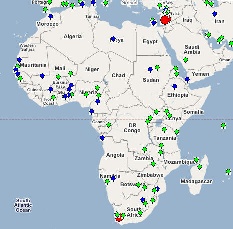...
Opportunities
In 2006 Africa had reached close to 1 billion people or about 14% of the world's population. Its usage is also growing faster than the rest of the world. However, the Internet penetration shown in the table below is only about 3.6% so it is a huge potential market.
...
At the same time there are promises of considerably increased fibre connectivity to sub-Saharan Africa, see figure 1514. In fact, four major undersea cable projects are currently engaged in a race to be the first to lay a fibre-optic link connecting the eastern seaboard of Africa to the rest of the world, with the most vicious competition centering on the connections to Europe, which is the destination for 85 per cent of international bandwidth traffic in Africa. The four projects are the East African Submarine Cable System (Eassy), Seacom, TEAMS and Reliance of India. The goal is to have these cables in place in time for the Soccer World Cup in South Africa in 2010.
Figure 1514: |
|
|---|---|
|
GEANT has connections to EuMed in particular Marocco, Algeria, Tunisa and Egypt, see http://www.dante.net/upload/pdf/EUMED-poster.pdf . They are now working on connecting to Ubuntunet East and Ubuntunet South.
Also the UN, governments such as China, the UK, Europe, the US and companies such as AMD, Intel,Microsoft, Cisco, Nokia and Ericsson are recognizing the opportunities and needs and investing. This will introduce challenges of new development models such as more inclusive business models; bottomsbottom-up approach; working in new regulatory, policy and poor infrastructural availability environments; working with governments and others to ensure fibres are installed with any major relevant projects (railways, roads, electricity pylons etc.); micro-payments; content in many new local languages; use of wireless for last mile connections; Internet kiosks and cafes, etc.
...
The PingER project is arguably the most extensive active end-to-end Internet performance measurement project today. It Its data goes back over a decade and more recently has focused on measuring the Digital Divide. It covers measurements from over 16 countries to over 150 countries (see Figure 1615) containing over 99% of the world's Internet connected population. 45 of the countries are in Africa.
Figure 16a15a: PingER Deployment Dec 2007, red are monitoring sites, blue beacons that are monitored from most monitoring sites and green the monitored only sites. | Figure 16b15b: Google map of African sites Dec 07 |
|
|---|---|---|
|
|
...
One way of showing how Africa is behind the rest of the world from the point of view of PingER Internet measures is to show compare maps of the performance for several metrics for January through September 2007. These are shown in the Figures below.
...


